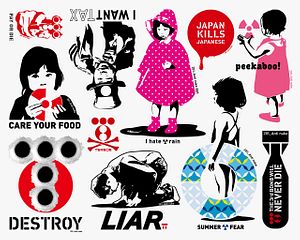Though his artwork lasts an average of three days before being taken down or covered up, 281_Antinuke’s politically charged stickers have propelled the Japanese street artist to international fame – he’s been profiled in publications ranging from The Guardian to Rolling Stone and even has a documentary on the film festival circuit.
Unfortunately for the controversial artist, 281 (for short) hasn’t had nearly as big an impact on his homeland.
“It’s a shame but 90 percent of the people who get in contact with me are from abroad, maybe because foreigners are more used to looking out for street art with a message,” 281 told Reuters.
While graffiti has existed for decades as a popular – albeit illegal – form of artistic expression in the West, 281’s “vandalism” is in stark contrast to his generally conformist Japanese society. The anti-nuke crusader, known for conducting interviews in a white surgical mask and dark sunglasses to protect his identity, has been compared to British graffiti superstar Banksy.
“His works bring a message,” said Roth Management, 281’s agent. “When you see [them], like Banksy, it usually takes a few moments to realize the true message … they are always based around politics and real issues of the time.”
Some of 281’s most iconic graffiti criticizes the lack of preparedness and slow cleanup of the March 11, 2011 nuclear disaster in Fukushima – referring to it as the “third bomb” or redesigning the TEPCO logo as a skull and crossbones. There are more than 160 variations of his best-known sticker – a little girl in a raincoat shielding herself from a radioactive downpour.
“Perhaps because everyone believes people telling them on television that everything is fine, they don’t seem so worried,” 281 added. “I hope by leaving my art I can remind people that we’re not safe at all … We don’t know what will happen in the future, whether children will get cancer or leukemia, so I want to keep making noise and making a fuss.”
More recent designs target the 2020 Olympics and the approval of a consumption tax increase – the country’s first since 1997. One shows Japanese Prime Minister Shinzo Abe running with the Olympic torch as radiation symbols trail behind it. Another depicts former Prime Minister Yoshihiko Noda in the iconic “We Want You” Uncle Sam pose, with the caption changed to “I Want Tax.”
While 281 might not have mainstream success in Japan, he’s notorious among one small but vocal group of Japanese – the netto uyoku, or online ultra-nationalists. He has received hundreds of death threats and has had his official website come under attack.
281 was also forced to cancel an appearance at a Tokyo art show opening event in June due to concerns for his safety – despite organizers devising a back-door escape plan through the venue’s kitchen.
With the first Japanese reactor set to restart in July 2014, sightings of 281’s protest art, stuck to lampposts and alleyway walls around Tokyo, is bound to continue – unless the police or ultra-nationalists get to him first.
A gallery of 281’s work can be viewed here.

































